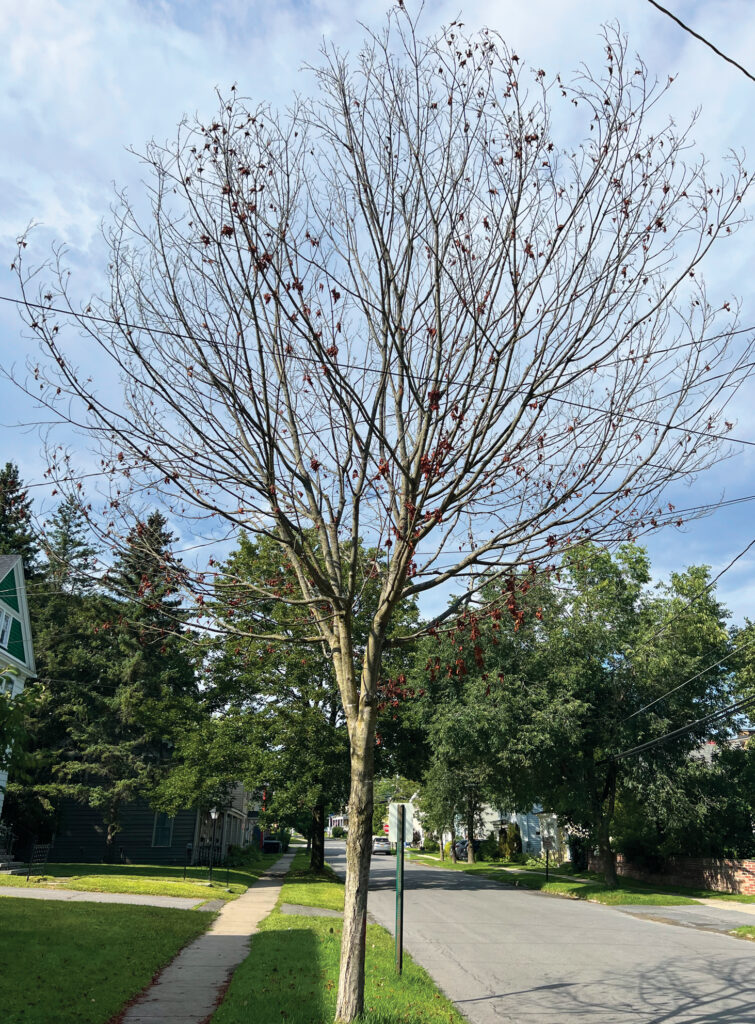Tree Inspection
Complete in Cooperstown

The Village of Cooperstown does a yearly assessment of all of the trees in the Village.
“The assessment went well this year. We were fortunate to have five members of the Tree Committee able to attend. We did it with 5 sets of eyes which is fantastic,” Cindy Falk, Deputy Mayor and Chair of the Streets Committee.
“We have a number of village trees where it’s clear that parts of them have either already dropped their leaves or never had leaves at all this year,” Ms. Falk said. “We wanted to make sure we captured that and weren’t mistaking it for what normally happens in the fall, that’s why we did the survey earlier this year.”
“The Village is responsible for the trees that are between the sidewalk and the street, or within the village right of way,” she said. “We had some unusual weather this year that caused a lot of problems. Large branches came down, entire trees came down,” Ms. Falk said.
“We have had limited rainfall, and while we are not officially in a drought, it has been a drier summer. When trees don’t get enough water, they have a tendency to break more easily,” she said.
A near drought plus severe storms add to the problems. “Lately when we do get rain, we get these immense storms that come with high winds and lightning,” she said.
When we’re inspecting Village trees, we’re looking for trees that are split, or have holes from woodpeckers. Things that would increase the risk factor,” she said. “We look for trees that are dead, trees that have dead areas, branches too close to houses, and trees that need to be elevated over the sidewalk,” she said. The rule of thumb is that trees cannot have less than eight feet between the sidewalk and the lowest tree branch.
“Sometimes you can get away with that when the trees are small but as they grow you know we try to elevate them so there’s room to walk underneath them,” she said.
“NYSEG (the utility provider in the Village) is primarily responsible for power line issues. They are very attentive,” Ms. Falk said. “There are many trees in the village that are on the same side of the street as the overhead wires and clearly that can cause problems if a branch breaks.”
“There isn’t anything we can do about trees that were planted 100 years ago that are interfering with sidewalks and power lines, but we try not to plant trees that are going to become huge.”
The Village had a professional tree assessment done by arborists using money from the department of environmental conservation back in 2018. In the tree survey they assessed the risk factors for all the village trees.
“I know one of the things that they were really pleased about was that we have so many mature trees in the village and that over the years we’ve done a good job maintaining our trees. There are a lot of trees that go back to before WWII that are lining our streets,” she said.
“The flip side to that is that one of the things they told us we should be doing more of is planting young trees, that we couldn’t just rely on the mature trees to be here forever, but instead that we should be continually investing in our urban forest, so that as the mature trees do come down there’s not a gap that we have to catch up to fill but that we have young trees that are already starting to grow,” she said.
Once we decide what we need, the Village requests bids to perform the service.
“We recommended about two dozen trees that need to be removed, and about three times more than that that need trimming. The work won’t happen until the winter or until next spring when the leaves start to come out again,” Ms. Falk said.
“We also reduced our tree budget when it came to planting during the pandemic. So many of our revenues were down that that was an unfortunate place where we had to make cuts. This year we are back up to do our regular planting and we got an additional grant through the Arbor Day Foundation to plant even more.”
Over the years I’ve been doing this, people have been generally favorable toward trees for good reason. They help with cleaning the air and water, and they provide shade which reduces energy costs,” Ms. Falk said.
“I think what’s been interesting this year is that we are more increasingly aware of the risks. You need to balance those two. We certainly in no way want to get rid of our trees but at the same time, we need to be aware and make sure we are fostering healthy trees and not creating hazardous conditions,” Ms. Falk concluded.

